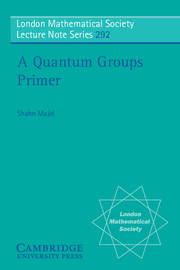Book contents
- Frontmatter
- Contents
- Preface
- 1 Coalgebras, bialgebras and Hopf algebras. Uq(b+)
- 2 Dual pairing. SLq(2). Actions
- 3 Coactions. Quantum plane A2q
- 4 Automorphism quantum groups
- 5 Quasitriangular structures
- 6 Roots of unity. uq(sl2)
- 7 q-Binomials
- 8 Quantum double. Dual-quasitriangular structures
- 9 Braided categories
- 10 (Co)module categories. Crossed modules
- 11 q-Hecke algebras
- 12 Rigid objects. Dual representations. Quantum dimension
- 13 Knot invariants
- 14 Hopf algebras in braided categories. Coaddition on A2q
- 15 Braided differentiation
- 16 Bosonisation. Inhomogeneous quantum groups
- 17 Double bosonisation. Diagrammatic construction of uq(sl2)
- 18 The braided group uq(n+). Construction of uq(g)
- 19 q-Serre relations
- 20 R-matrix methods
- 21 Group, algebra, Hopf algebra factorisations. Bicrossproducts
- 22 Lie bialgebras. Lie splittings. Iwasawa decomposition
- 23 Poisson geometry. Noncommutative bundles. q-Sphere
- 24 Connections. q-Monopole. Nonuniversal differentials
- Problems
- Bibliography
- Index
17 - Double bosonisation. Diagrammatic construction of uq(sl2)
Published online by Cambridge University Press: 18 January 2010
- Frontmatter
- Contents
- Preface
- 1 Coalgebras, bialgebras and Hopf algebras. Uq(b+)
- 2 Dual pairing. SLq(2). Actions
- 3 Coactions. Quantum plane A2q
- 4 Automorphism quantum groups
- 5 Quasitriangular structures
- 6 Roots of unity. uq(sl2)
- 7 q-Binomials
- 8 Quantum double. Dual-quasitriangular structures
- 9 Braided categories
- 10 (Co)module categories. Crossed modules
- 11 q-Hecke algebras
- 12 Rigid objects. Dual representations. Quantum dimension
- 13 Knot invariants
- 14 Hopf algebras in braided categories. Coaddition on A2q
- 15 Braided differentiation
- 16 Bosonisation. Inhomogeneous quantum groups
- 17 Double bosonisation. Diagrammatic construction of uq(sl2)
- 18 The braided group uq(n+). Construction of uq(g)
- 19 q-Serre relations
- 20 R-matrix methods
- 21 Group, algebra, Hopf algebra factorisations. Bicrossproducts
- 22 Lie bialgebras. Lie splittings. Iwasawa decomposition
- 23 Poisson geometry. Noncommutative bundles. q-Sphere
- 24 Connections. q-Monopole. Nonuniversal differentials
- Problems
- Bibliography
- Index
Summary
Whereas the last lecture was about ‘bosonisation’ and led to the uq(b+) quantum groups, this time we will do ‘double bosonisation’ and the construction of uq(sl2) by these braided group methods. Note that this approach is a little idiosyncratic but it provides, in my opinion, the deepest insight into the construction of quantum groups of this type. This is also the last lecture with ‘braid diagrams’ – we finish up this middle section of the course. We will, however, link this approach with Lusztig's in the lecture after this one.
First of all, a few final remarks about bosonisation. Although we gave the proof quite explicitly, its real content is no more than the (quite elementary) construction of a monoidal category from B – the category BC of braided modules in C - HM. After this, it is more or less clear that there is some ordinary Hopf algebra (in our case B⋊H) whose modules are this category. The abstract formulation of this last step is called ‘Tannaka-Krein reconstruction’ – given a monoidal category C and a monoidal functor C → Vec obeying some technical conditions, there is an ordinary Hopf algebra in Vec such that the functor factors through its modules. In nice cases this identifies C with this category of modules. There is also a technically superior comodule version.
Moreover, bosonisation itself provides a kind of ‘functor’ from braided groups of a certain kind (in module or comodule categories) to ordinary Hopf algebras. There is also a partially denned ‘functor’ in the other direction.
- Type
- Chapter
- Information
- A Quantum Groups Primer , pp. 105 - 112Publisher: Cambridge University PressPrint publication year: 2002



